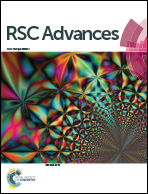New insights on the dynamics of the γ-Fe/α-Fe phase-transition inside iron-filled carbon nanotubes†
Abstract
One of the challenges in the field of carbon nanotubes (CNTs) is the encapsulation of a single crystalline phase of ferromagnetic α-Fe. The formation of additional γ-Fe and Fe3C phases during CNT-growth generally limits the direct encapsulation of these crystals in the form of a single phase. A solution, the use of post-synthesis annealing, has been considered; however oxidation of the encapsulated metal-phases is commonly found due to the elevated temperatures (T) necessary for the phase-conversion. Here we investigate the dynamics of γ-Fe to α-Fe transition by T-dependent X-ray diffraction in vacuum. We show that a direct γ-Fe to α-Fe transition is present already below 200 °C and becomes significantly fast in the T-range of 300–399 °C. In such a T-range no metal oxidation is found. Rietveld refinement analyses also show that a T-dependent increase in the unit-cell c-axis value of the graphitic CNT-walls is present.



 Please wait while we load your content...
Please wait while we load your content...